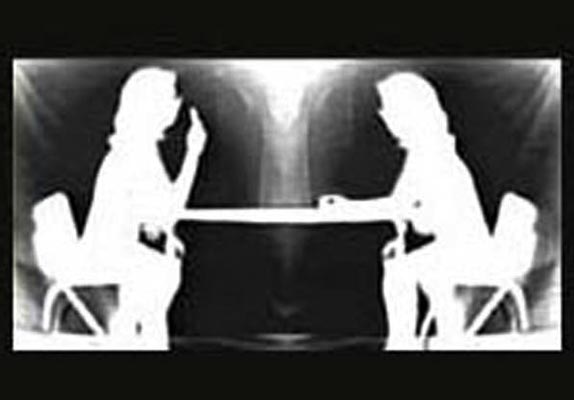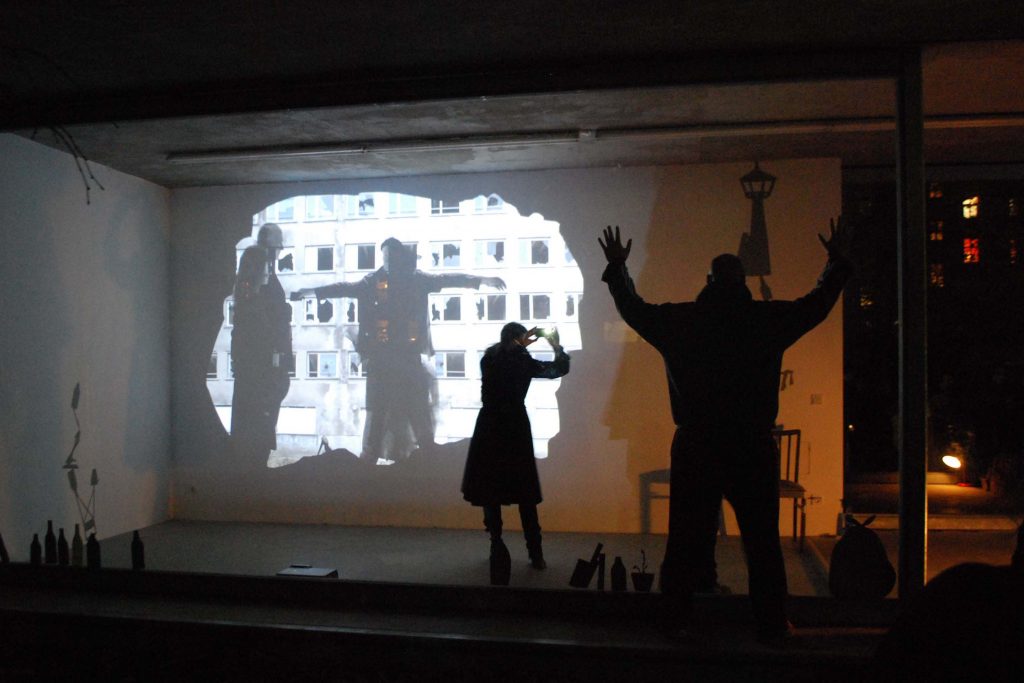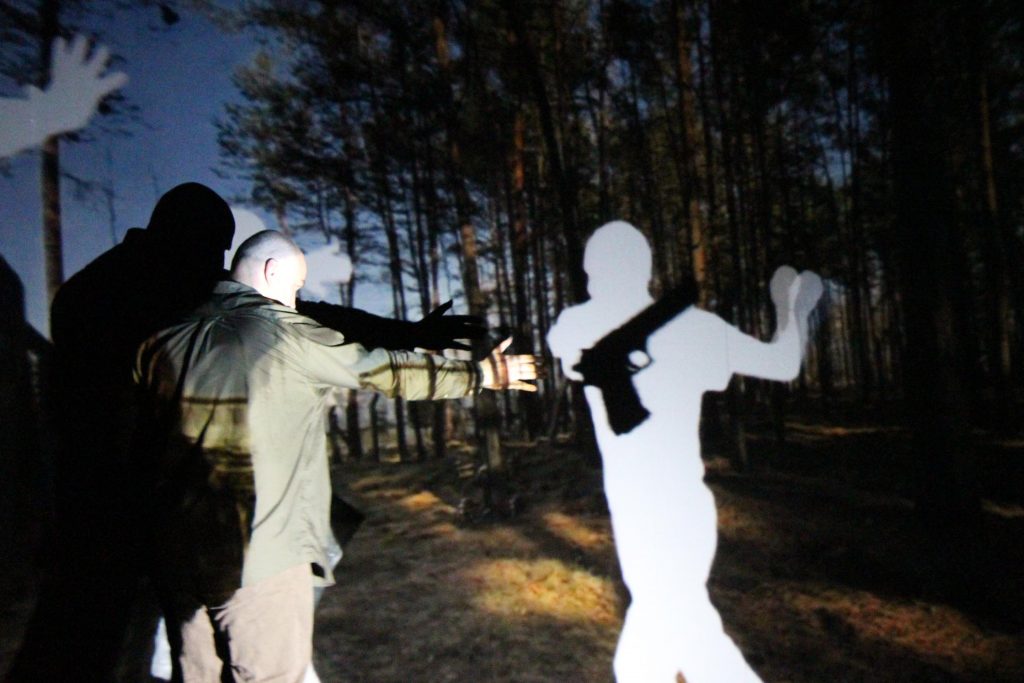The Silhouettes of Sharon Paz
Angelika Richter

A female figure at a table slowly inserts a long object into her mouth and begins to eat it. Her mirror image opposite does the very same thing, but in the reverse order and removes the swallowed object whole from her mouth. The looped scene is represented in negative film images. The two figures, the chairs, and the table are bright, while the background remains dark. Sharon Paz’s early work entitled Eating and Re-Eating (1998), which she created while a student at New York’s Hunter College, is one of many from this period where the artist deals with existential and sensual aspects. Mostly using her own body as a medium and a material, she engages in these works in simple everyday acts like eating, Kissing (1999) and Peeing (1999) – both further early videos by her. The minimalist interventions and their presentation in a simple, stark black-and-white aesthetic that recalls the appearance of photograms are an expression of the expansion of the self-portrait using film. But they point beyond purely artistic self-reflection by including the research of the body viscerally and anticipating all the qualities revealed in Paz’s complex performances and video installations today.
The title of her 1998 video work reflects and underscores the moment of the repeating act on a linguistic level, an act that by way of its multiplication and its recurrence in the cycle of images can reveal a quite absurd dimension. The two veterans in wheelchairs sitting opposite each other in Paralyzed Movement (2014) are caught in time, in their paralyzed bodies and always repeating the same gestures of rising up. The same is true of the actors in Restraining Motion, created that same year, in which as part of the formation of a human chain, not following any recognizable constraints, objects are continuously handed on from person to person and given back. The media-reflexive mirroring of ingesting food in Paz’s early video also includes the synchronization of events, spaces, and images that would follow in her later works after completing her studies.
Born and raised in Israel, Sharon Paz comes from a country that is not just shaped by a complex mix of various ethnic backgrounds and religions, but also by numerous armed conflicts that can be traced back to the history of the Holocaust in Germany, the country where the artist lives today. In The Right to Leave (2013), Paz links Israeli and German landscapes; in Open | Close (2014), Jerusalem’s Lion’s Gate is associated with depictions of fences that are reminiscent both of various state borders and the entrances to Auschwitz and Buchenwald. The violent occupation and destruction of homes in Shaded Windows (2012) and Sinking Land (2015) conjure up images of Israel’s territorial policy of expansion on the West Bank. At the same time, these are locations, specified in no further detail, that are evoked as metaphors for nation-building, for displacement, and for historic and current wars.

The site-specific performance of Shaded Windows doubles the experience of violent conflicts, making them palpable for the audience and moving them directly to the present. In her works, Paz makes the use of different times and local events visible as an artistic intervention and process, while at the same time obfuscating this use. By short-circuiting the various artistic media of video and performance or projecting visual material of a former Jerusalem hospital for leprosy patients onto historical furniture and interiors in Marks of Existence (2015), she signals temporal and local fissures. Paz’s early video works depict interior views transported via the body, while her current productions deal with her situation as a migrant and the historical situation of her country of origin and her chosen home; what all her works have in common, however, is their performance character. Actions from her early work, following the tradition of body art, are carried out in the private sphere of the studio. The audience only obtains access to the filmed document. Paz’s performances today, always in combination with video projections, sometimes large in format, take place in public as a theatrical event. The actions now are no longer embodied by the artist herself, but by several performers acting at the same time in front of and behind the screen. Bringing together and simultaneously separating filmic image and performance and the layering of several levels of action in the video itself can also be found in the early work discussed at the opening of this essay. Paz moves the artistic action of eating behind a fabric that covers the entire image, transparent enough to make the events visible, but nonetheless covering and veiling them.
The moment of abstraction that leads away from concrete individuals, contexts, and sites of action crystallizes within Paz’s early works as negative images, outlines, and cutouts. Since 2009, this has taken place through the appearance of her film figures and that of her performers as black silhouettes. The play of shadows and their visual seductive power reveals only on second glance the artist’s critical and political interests. In the first works, which include The King is Blind (2011), the filmed and the shadow figures acting in real time both perform before two-dimensional images that in their stark appearance recall the genre of documentary animation. Her later videos are multilayered collages of film whose indexical constitution shows real locations and events. In several of her works, like We Forgot (2015), the artist involves viewers in the artistic narrative by allocating them to an active position: either they can interact freely with the figures of the video images or they can follow precise instructions for their actions. In joint shadow play with the filmic schemes, they generate new complexes within processes of negotiating memory culture as the attempt to capture the blind spots of memory.

By using shadows as a visual strategy, Sharon Paz opens a “negative” space of reflection that enables beholders to recognize all sorts of individuals as well as themselves in the undescribed surface of the bodiless shadow, and to project their own visions. Furthermore, the “shadows of reality” in the video and the performance are assigned the function of activating historic and contemporary events and images from the oblivion of forgetting.